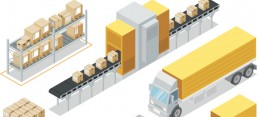The Road Forward for the Supply Chain Industry
The world is changing, and so is the supply chain. Several factors have affected the way supply chains are designed, managed, and operated over the last few decades, e.g. increasing globalization, a shift in customer demand and expectations, and others, but the single biggest factor affecting the growth and structural change of most supply chains is technology – driven mostly by three core developments: the introduction and widespread use of the smartphone, expanded and freely available internet bandwidth, and connectivity at levels far greater than ever before via cloud-based solutions.
The report, Material Handling & Logistics U.S. Roadmap 2.0 (powered by MHI) takes a detailed look at the changing supply chain landscape by focusing on the four key forces in the supply chain: technology, consumers, workforce, and logistics infrastructure.

Technology
The technologies that drive supply chain, logistics and material handling are experiencing rapid change, with plenty of constantly evolving, competitive technology, and this will continue to be the case going forward.
Consumers
The modern consumer is far from monolithic. Individual preference plays a large role, and each of the five distinct age-based demographic groups have their own outlooks, attitudes, and characteristics – all of which have a distinct influence on buying patterns and consumption habits.
Workforce
Although logistics and materials handling activities have been around, in one form or another, for a long time, supply chain management as a formal profession is less than 30 years old. This relative newness means that the industry has not yet become set in its ways, with a lot of flexibility and agility being shown in the different ways supply chains are run and managed by different people.
On the other hand, though, being relatively new means the profession still has to prove its worth and be recognized for the vital role it plays in many industries.
Logistics Infrastructure
Often, to those outside the industry and not fully familiar with its dynamics, it can seem as if logistics infrastructure is unlikely to change much in the next few years. However, a closer look will show that fundamental change is indeed happening, both in the way goods are physically handled, and in the way digital information about goods and processes is playing an ever-greater role.
